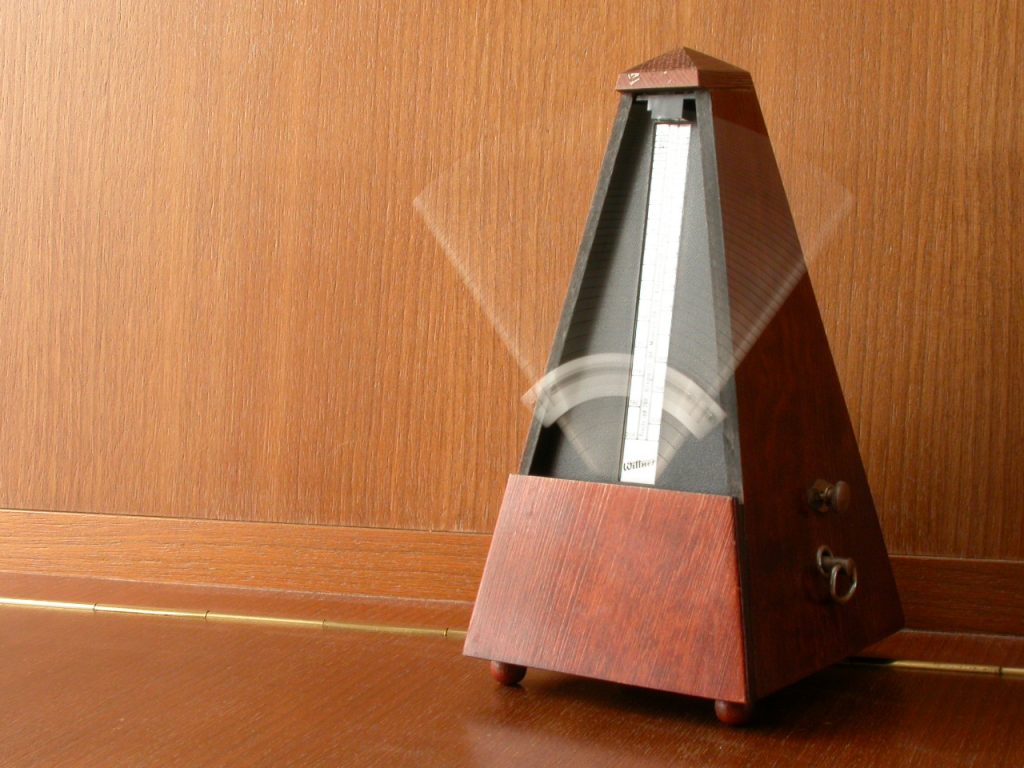How to Use a Metronome to Learn a Jig

When you are learning a new jig, do you often have trouble staying “on the beat” because you are using all of your concentration just to play all of the melody notes, gracenotes and embellishments correctly? Then, after you get those pesky things out of the way, are you still having trouble getting that “jig feel”? Using a metronome during your practice may well be a useful tool for you.
As we mentioned in an earlier post ("How to Use a Metronome to Improve Your Piping"), the metronome is a highly accurate and useful tool that, when used appropriately, can vastly improve our rhythmic accuracy and musicality. Yes, it is also an unrelenting truth detector. This article continues along the path of how to approach using a metronome to improve our playing, but this time with a jig.
Jigs are in a 6/8 time signature. While the eighth note groupings in a jig can be played either “round”, or dot-cut, modern jigs are primarily played round, yet with a slight pulse on the downbeat. Although there are 6 eighth notes in a bar and each eighth note theoretically gets a beat, each beat of a 6/8 is divided into 3 parts. Thus, there are 2 beats to a bar. See figure 1.

The first line of this classic jig, Banjo Breakdown, contains eighth notes and quarter notes. Missing in this line is the remaining element of a round jig, the dotted quarter note.
A good first step in learning a jig, especially for novice pipers, is to use the metronome to help you play the tune in “triple time”. In triple time, each eighth note gets a “click”, a quarter note gets two clicks, and a dotted quarter note would get three clicks. So, if the metronome was set to 90 clicks per minute in triple time, the actual beats per minute would be only 30 bpm. This tempo obviously is quite slow, but in triple time you will be playing a note a little faster than one each second, which might be just right for making sure that all the notes are correct.
Let’s look at an example (See Figure 2), where the first line of Banjo Breakdown is shown marked in triple time.

Note that the G-D-E gracenotes are each played on a click. Also, the G gracenote in the C doubling is played on a click, and since the C is a quarter note, it will be held for two full clicks in triple time. The arrows in Figure 2 may not appear to be distributed proportionately across the music because the music notation itself is not evenly spaced. However, the music should be played perfectly on the clicks of the metronome.
Even though playing in triple time is a good way for many pipers to approach a new jig, the ultimate goal is to play in single time, and at a tempo of at least 90 bpm, at which point a jig starts to sound like a jig! And only in single time can the first downbeat of a bar begin to get “pulsed”, where the first eighth note in a group is held for a tiny bit more than the other eighth notes. Remember, the rhythm of a jig is often vocalized as “jig-i-ty”, with the “jig” getting a bit more time.
After becoming comfortable with a new tune in triple time at a tempo of say, up to 120 bpm, it becomes a bit unwieldy to go much faster in triple time. Thus, it’s now time to switch to single time and continue to build your tempo. In Figure 3, the arrows now indicate simple time for the metronome. Each bar contains two beats. Be sure to play everything correctly relative to the beats, and play each step of the embellishments, before increasing the tempo. And even then, increase the tempo only 2-3 bpm at a time and assure that you can maintain your accuracy.

At this point, if you have approached your jig “the Dojo way”, by mastering each bar or phrase before moving to the next, and you have been using a metronome to assure rhythmic accuracy and precision, it’s now only a matter of time before your jig comes alive musically. Don’t rush. Play slowly enough that you play everything correctly, and rhythmically. Only then will you be playing good music. Remember, if you can’t play something slowly and correctly, you will not be able to play correctly at a faster tempo.



Responses